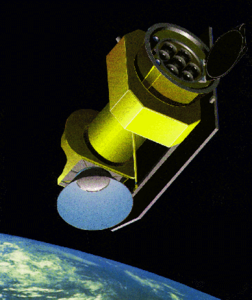ABRIXAS
| ABRIXAS | |
|---|---|

|
|
| Type: | X-ray telescope |
| Country: |
|
| Operator: | DLR |
| COSPAR-ID : | 1999-022A |
| Mission dates | |
| Dimensions: | 470 kg |
| Begin: | April 28, 1999, 20:30 UTC |
| Starting place: | Capustin Jar |
| Launcher: | Cosmos-3M |
| Status: | burned up on October 31, 2017 |
| Orbit data | |
| Rotation time : | 94.5 min |
| Orbit inclination : | 48.4 ° |
| Apogee height : | 513 km |
| Perigee height : | 489 km |
ABRIXAS (abbreviation for A Broadband Imaging X-ray All-Sky Survey ) was a space telescope with which the entire sky was to be mapped in the X-ray range at energies of 0.5-15 keV .
The small satellite ABRIXAS was developed by several German research institutes in order to supplement the successful sky survey in soft X-ray light by ROSAT towards higher energies. With improved detector technology, better angular resolution and spectral resolution should also be achieved than with ROSAT. The satellite was built by the Bremen company OHB-System . The satellite was to explore the sky for six years.
ABRIXAS was launched on April 28, 1999 with a Russian Kosmos 3M rocket from the Kapustin Yar launch site. Shortly after the start, the main battery failed due to a design error due to overheating because the starter battery was overcharged. After failed attempts to establish contact, the ABRIXAS scientific mission was officially declared to have failed on July 1, 1999.
On October 31, 2017, the functionless satellite reentered the earth's atmosphere and burned up.
Web links
- Max Planck Institute for Extraterrestrial Physics: Chronology of the ABRIXAS Mission (archived 2017)